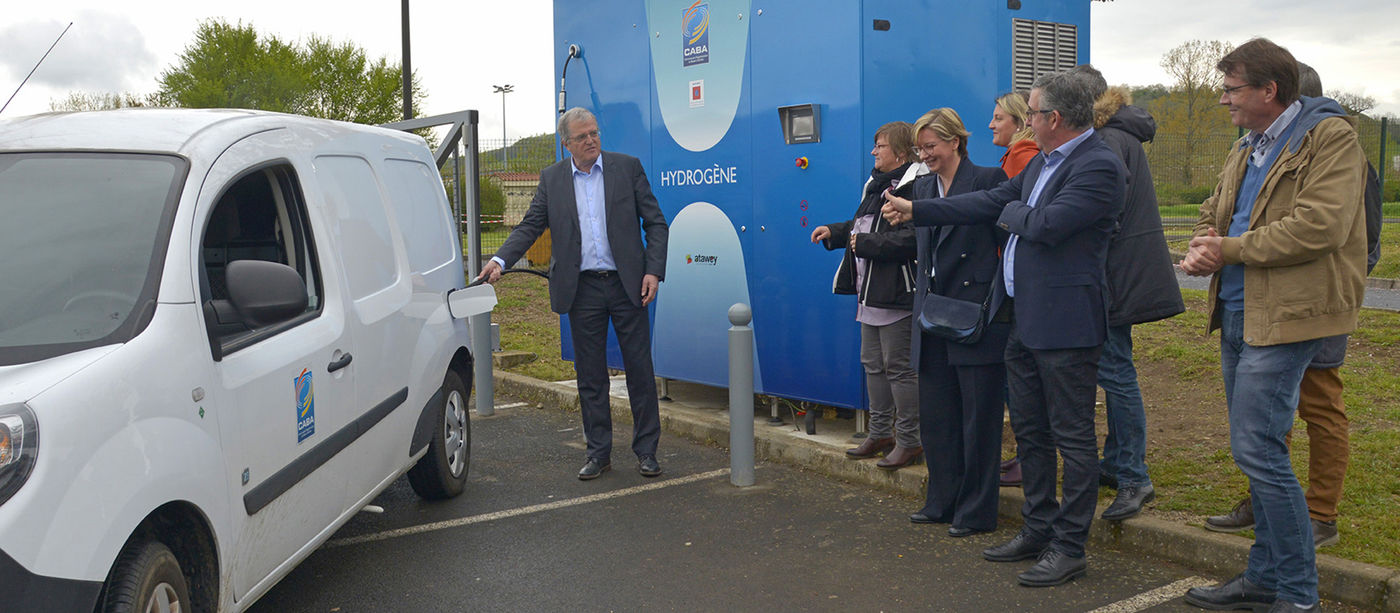
Concerned with preserving the environment, the Agglomeration Community of the Bassin d’Aurillac carries out many actions in terms of sustainable development. It works in particular to promote renewable energies and “green” mobility. A hydrogen production and distribution station has just been installed in the Aquatic Center car park (epicenter). It makes it possible to produce and store hydrogen energy through a simple supply of drinking water and electricity.
A territory with great potential
The political will of CABA is to conduct virtuous approaches to sustainable development. A desire that is already reflected in the implementation of numerous actions around fuel poverty (OPAH), electric mobility (buses and electric bicycles), thermal improvement of buildings (STABUS, airport terminal, LED lighting, etc.). creation of a park and photovoltaic roofs in Tronquières, the setting up of a heat network from the Souleyrie sludge incinerator, the obtaining of the “Energie Positive Territory for Green Growth” label (TEPCV), the setting in place of a Climate-Air-Territorial Energy Plan (PCAET) within the framework of the SCoT Joint Syndicate at the level of the three intercommunalities: CABA, Cère and Goul in Carladès and Cantalian Châtaigneraie.
According to the statistics of the Ministry of the Ecological and Solidarity Transition of September 2018, in the field of photovoltaics, Cantal represents 2.95% (1,989 installations) of the Auvergne-Rhône-Alpes region and produces 16,2% of the power produced in the region (146 MW including 40 MW on the photovoltaic fields of Marmanhac, Jussac, Aurillac and Arpajon-sur-Cère). Although the Aurillac Basin is highly dependent on fossil fuels, particularly in terms of travel, our territory has a strong potential for the production of renewable energies.
This double observation has led elected officials to want to implement a project aimed at:
– producing energy with the region’s resources,
– being able to store and consume it locally, favoring medium-term mobility,
– federating local actors to make it a territorial project
Hydrogen production: how does it work?
Hydrogen is obtained through the electrolysis of water: an electrolytic process that decomposes water into oxygen (O2) and gaseous hydrogen (H2) by means of an electric current.
Able to independently produce 2 kg of hydrogen a day and store 7 full days of production, this station allows the daily recharge of 1 to 4 light vehicles, in an accelerated way.
Its operation and maintenance were entrusted to ENGIE Cofely. They obey, particularly in terms of safety, the regulations and technical characteristics of this type of installation, such as fuel dispensing stations or the storage and sale of domestic gas cylinders in common use.
An electric hydrogrene fleet
Within the Community fleet, two Kangoo ZE-H2 electric vehicles with hydrogen range extender were purchased (€ 54,000 excluding tax). They are used by the works inspectors for their travels on construction sites. Near the station, was also installed a terminal for recharging these vehicles in electricity.
The desire is to open, in the framework of conventions, the use of this equipment to all those who wish to embark on these new modes of travel. Several administrations and companies have expressed their desire to equip their fleet with hydrogen vehicles and to have this source of supply.
Made available to ENGIE Cofely
Beyond the maintenance of the station entrusted to it by CABA, ENGIE Cofely * wanted to take part in this innovation by acquiring a hydrogen vehicle in July 2018 for its operating team based in Aurillac. This vehicle, also type Renault Kangoo ZE-H2, is able to connect to our hydrogen station. This solution perfectly matches the operating criteria of ENGIE Cofely’s fleet of 50 vehicles and reinforces its commitment and its pioneering position in favor of green mobility.
Funding
For the acquisition of this station from the Atawey / Engie consortium at a cost of € 250,000, CABA benefited from state support under the AURATRANS agreement of ADEME for € 50,000.
Read the most up to date Fuel Cell and Hydrogen Industry news at FuelCellsWorks




